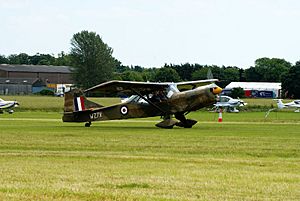Auster AOP.9 facts for kids
The Auster AOP.9 was a special kind of small airplane used by the military. It was designed and built in the UK between 1955 and 1960. This aircraft was mainly used by the British Army and the Royal Air Force for important jobs like watching over areas and carrying messages or people.
Contents
What is the Auster AOP.9?
The Auster AOP.9 is known as a "light military aircraft." This means it's a smaller plane, not a big fighter jet or a large transport plane. It was built to be very good at flying slowly and at low altitudes. This made it perfect for its specific tasks.
Designed for Special Missions
The "AOP" in Auster AOP.9 stands for "Air Observation Post." This tells us exactly what the plane was made for. Its main job was to fly over battlefields or other areas to observe what was happening on the ground. It could spot enemy movements or help direct friendly forces.
Why Observation Was Important
Being able to see from the sky was a huge advantage for the Army. The Auster AOP.9 could fly above the ground and give commanders a clear view. This helped them make smart decisions during operations. It was like having a pair of eyes high in the sky.
What is Light Liaison?
"Light liaison" means carrying important messages, small supplies, or a few people quickly between different locations. Imagine needing to get a message to a distant outpost or move a commander to a new position. The Auster AOP.9 could do this efficiently.
Who Used the Auster AOP.9?
Both the British Army and the Royal Air Force (RAF) found the Auster AOP.9 very useful. Each branch used it for slightly different but equally important roles.
The Army's Sky Eye
For the British Army, the Auster AOP.9 was often used to help artillery units. An observer in the plane could watch where artillery shells landed. They would then radio down corrections to make sure the next shots hit their target. This made artillery much more accurate.
The RAF's Versatile Plane
The Royal Air Force also used the Auster AOP.9 for observation and liaison duties. They might use it for training pilots or for general communication tasks. Its ability to take off and land in small spaces made it very flexible.
Key Features of the Auster AOP.9
The Auster AOP.9 had several features that made it good at its job. It was designed to be sturdy and reliable. It could operate from rough, unprepared landing strips, which was crucial for military use in various terrains.
- High Wing Design: The wings were placed high on the body of the plane. This gave the pilot and observer a better view downwards, which was great for observation.
- Slow Flight Capability: It could fly very slowly without stalling. This allowed the crew more time to observe details on the ground.
- Short Take-off and Landing (STOL): The plane could take off and land in very short distances. This meant it didn't need long runways, making it useful in many different places.
The Auster AOP.9 was a simple but effective aircraft. It played an important role in supporting ground forces and helping with various military tasks during its service years.
Images for kids





